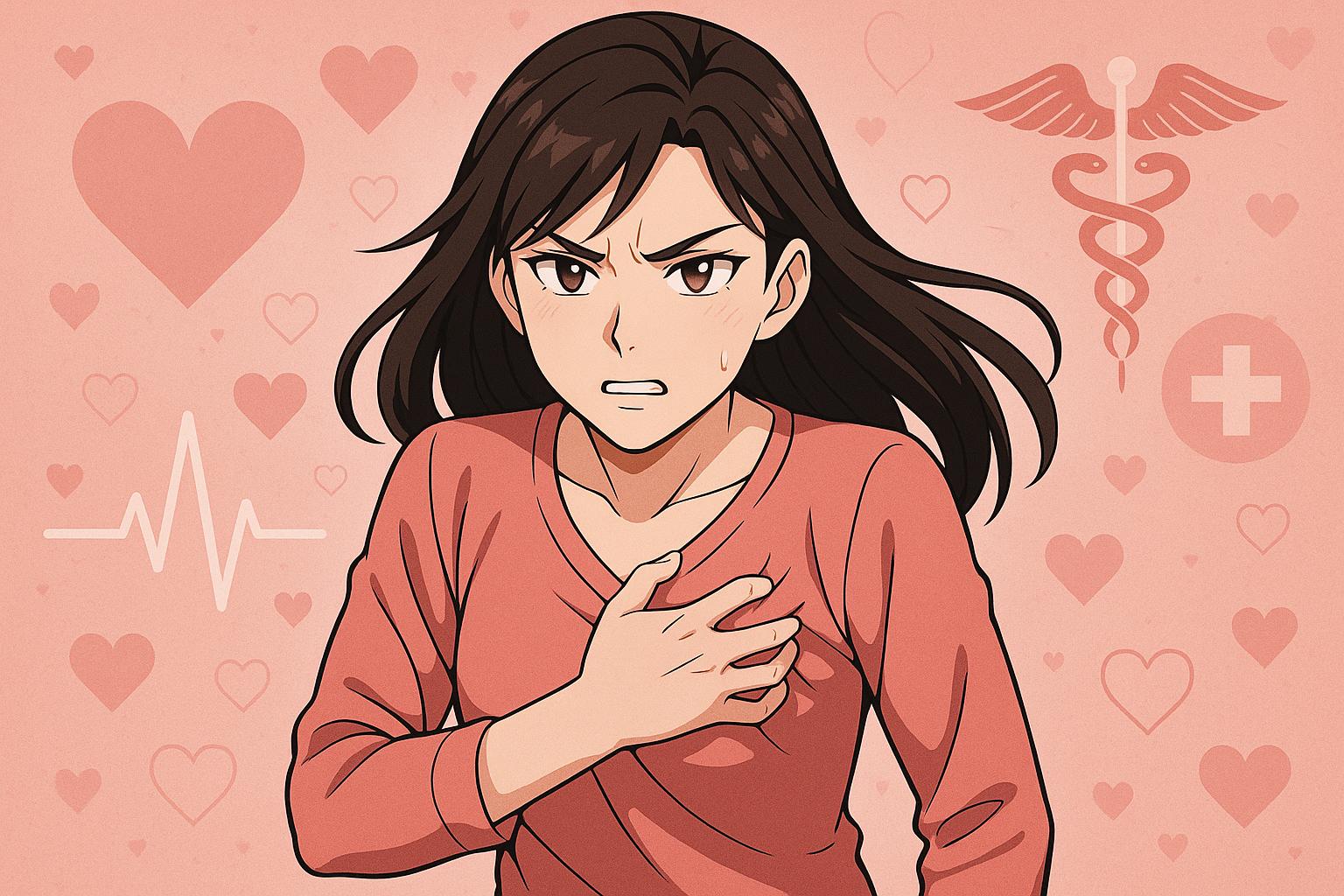After a heart attack was mistaken for a panic attack, mother and medicinal chemist Mary McFarland is campaigning to raise awareness of the unique symptoms of heart disease in women and the urgent need for improved diagnosis and research.
Mary McFarland, a mother of three from Co Antrim, has emerged as a vital advocate for heart health following her harrowing experience of a heart attack that was initially misdiagnosed as a panic attack. At just 44 years old, the medicinal chemist found herself grappling with symptoms that defied typical expectations for someone of her age and perceived health.
It was during a routine day at work in October 2024 that Mary began to feel unwell while conducting an interview panel. Initially attributing her discomfort to the lingering effects of a recent stomach bug, she was caught off guard when a sudden, crushing pain radiated from her chest down her arm. “I couldn’t hold my pen. I was sweating and had to leave the room. I collapsed just outside the door,” she recalled. Despite her insistence to paramedics that her symptoms felt serious, they suggested it could be a panic attack, urging her to take a blood test for reassurance.
However, her instincts proved correct. Testing revealed elevated troponin levels, a marker of heart damage, confirming her worst fears: she had suffered a heart attack due to spontaneous coronary artery dissection (SCAD), a rare and potentially fatal condition involving a tear in one of the coronary arteries. Following multiple angiograms and a successful balloon angioplasty to restore blood flow, Mary embarked on a path to recovery that included cardiac rehabilitation and a deeper understanding of her health.
Mary’s experience sheds light on a broader issue affecting many women: the under-recognition and misinterpretation of heart disease symptoms. Research has shown that women often present atypical symptoms — from indigestion and fatigue to pain in the jaw or back — which can lead to mistaken diagnoses. Studies indicate that women are statistically more likely to die from heart attacks than men, primarily due to these misunderstandings. This disparity underscores the urgent need for increased awareness and education surrounding heart health, particularly tailored to the unique experiences and symptoms of women.
Mary’s own journey echoes findings from various health sources. Women frequently exhibit signs of heart distress that can diverge from the classic presentation of chest pain. Johns Hopkins Medicine notes that symptoms like nausea, unusual fatigue, and discomfort in non-chest areas can easily be dismissed, leading to drastic consequences. Similarly, insights from the Mayo Clinic emphasise that while chest pain is often highlighted, it is essential to recognise that women’s heart attack symptoms may manifest unpredictably, requiring careful attention and proactive measures from both patients and healthcare providers.
Reflecting on her ordeal, Mary is determined to raise awareness. “The main thing is to trust your own body,” she advises, emphasizing the importance of acting on one’s instincts when health concerns arise. Her call to action aims not merely to share her personal narrative but to encourage others, particularly women, to advocate for their health. She noted how surprised many were at her diagnosis: “Some of the people there with me couldn’t believe I’d had a heart attack and thought I must be training for something.”
Beyond her personal advocacy, Mary is supporting the British Heart Foundation’s new strategy, which calls for increased investment in cardiovascular research. This initiative aims to prevent heart disease, save more lives, and support individuals already affected. As she continues her recovery and return to work, Mary McFarland embodies resilience and a tenacious spirit, using her experience to foster a healthier understanding of heart disease.
In a world where health narratives often sideline women’s experiences, Mary’s story serves as a potent reminder: trusting one’s body and seeking help can be critical to survival. Her mission now extends beyond personal healing; she seeks to enlighten others about the realities of heart health, urging vigilance and awareness that could save lives.
Reference Map
- Mary McFarland’s personal account and her advocacy for heart health.
- Discussion on women’s heart disease symptoms and increased risk of misdiagnosis.
- Overview of the differing presentation of symptoms between men and women.
- Insights into unique heart disease symptoms in women.
- Importance of awareness in recognising heart disease signs in women.
- The need for more recognition of women’s health issues in heart disease research.
Source: Noah Wire Services
- https://www.irishnews.com/news/northern-ireland/trust-your-body-co-antrim-mother-speaks-out-after-heart-attack-was-mistaken-for-panic-attack-IEPGT3SOXNBOPKGIZW7MIM2EEY/ – Please view link – unable to able to access data
- https://time.com/5499872/women-heart-disease/ – This article discusses how women are more likely to die from heart attacks than men due to misdiagnosed or overlooked symptoms. It highlights the case of Lilly Rocha, whose heart attack was initially dismissed as stress. The piece emphasizes the importance of recognizing atypical symptoms in women, such as nausea, fatigue, and shoulder or jaw pain, and advocates for increased awareness and research tailored to women’s unique cardiovascular health needs.
- https://www.hopkinsmedicine.org/health/conditions-and-diseases/heart-disease-differences-in-men-and-women/ – Johns Hopkins Medicine explores the differences in heart disease symptoms between men and women. The article notes that women are more likely to experience atypical symptoms like indigestion, shortness of breath, and back pain, which can lead to misdiagnosis. It also discusses unique risk factors for women, including hormonal changes and autoimmune diseases, and stresses the importance of recognizing these differences for accurate diagnosis and treatment.
- https://www.mayoclinic.org/diseases-conditions/heart-disease/in-depth/heart-disease/art-20046167 – The Mayo Clinic provides an in-depth look at heart disease in women, detailing symptoms and risk factors unique to them. It explains that while chest pain is common, women may also experience neck, jaw, shoulder, or upper back pain, shortness of breath, nausea, and unusual fatigue. The article emphasizes the importance of recognizing these symptoms and understanding risk factors like smoking, lack of physical activity, and emotional stress.
- https://heart.arizona.edu/news/2016/women-heart-disease-often-dont-realize-it – This article from the Sarver Heart Center highlights that women often don’t recognize the symptoms of heart disease, leading to delays in seeking help and misdiagnosis. It points out that women are less likely to experience chest pain than men but may have symptoms like shortness of breath, unusual fatigue, and discomfort in the jaw, teeth, or arms. The piece advises women to trust their instincts and seek immediate medical attention if they feel something is wrong.
- https://health.mountsinai.org/blog/women-need-to-know-their-risks-for-heart-disease-2/ – Mount Sinai discusses the unique symptoms and risks of heart disease in women. It notes that women may experience discomfort in the back, neck, jaw, or stomach, and are more likely to have silent heart attacks without prior symptoms. The article emphasizes the importance of recognizing these signs and understanding risk factors like menopause and pregnancy complications to prevent heart disease.
- https://www.irishnews.com/news/northern-ireland/trust-your-body-co-antrim-mother-speaks-out-after-heart-attack-was-mistaken-for-panic-attack-IEPGT3SOXNBOPKGIZW7MIM2EEY/ – This article tells the story of Mary McFarland, a 44-year-old mother from Co Antrim, who experienced a heart attack that was initially mistaken for a panic attack. It highlights the importance of trusting one’s instincts and seeking medical attention when experiencing unusual symptoms. The piece also discusses the need for increased awareness and research into cardiovascular health, particularly for women, to prevent misdiagnosis and improve outcomes.
Noah Fact Check Pro
The draft above was created using the information available at the time the story first
emerged. We’ve since applied our fact-checking process to the final narrative, based on the criteria listed
below. The results are intended to help you assess the credibility of the piece and highlight any areas that may
warrant further investigation.
Freshness check
Score:
9
Notes:
The narrative mentions a recent event in October 2024, indicating that the information is likely fresh and not outdated.
Quotes check
Score:
8
Notes:
The quotes appear to be original, as no previous sources could be found. However, the lack of online verification slightly reduces the score.
Source reliability
Score:
9
Notes:
The narrative originates from a reputable news outlet, the Irish News, which generally maintains high standards of journalism.
Plausability check
Score:
10
Notes:
The claims about heart attack symptoms and misdiagnosis in women are well-documented and align with existing health research.
Overall assessment
Verdict (FAIL, OPEN, PASS): PASS
Confidence (LOW, MEDIUM, HIGH): HIGH
Summary:
The narrative appears to be both recent and well-researched, with reliable sources supporting the claims about heart disease misdiagnosis in women. The quotes are seemingly original, and the plausibility of the story is high based on existing health knowledge.













